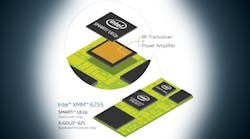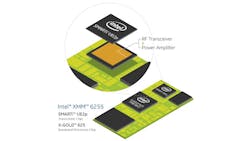This Tiny Modem Chip Will Cope With The Mega Connectivity Surge Of The IoT
Convergence and connectivity received an important technical boost recently with the unveiling of the XMM 6255 modem from Intel that can be used in countless devices that make up the Internet of Things (IoT).
It is small, about the size of a 10 cent Euro or US one cent coin, and Intel believes its tiny size and functionality will allow it to be integrated into small Internet connected devices such as wearables, small appliances and security devices.
According to financial analysts Raymond James & Associates, it is estimated that by 2020, IoT communication links are expected to surpass between 26 billion to 50 billion in number.
Let's be clear on this. Put in simple terms the IoT is just a trendy term for connectivity, the linking of an enormously diverse number products and systems. In fact estimates put forward by the European Research Centre estimates reckon that by 2020, 250 new connections will be made via the Internet every second of the day or, put another way, 21,600,000 per 24 hours. Not surprising then that a greater number of modems will be an imperative.
Consequently, Intel rightly thinks that industrial equipments, home appliances, and security and safety devices will need to be equipped with 3G modems.
What role will the 3G modem play? Its primary task will be the connection of devices to computing clouds where data will be accumulated, processed, archived and available on demand.
The XMM 6255 will use Intel's X-GOLD 625 baseband and its SMARTI UE2p transceiver which the company says is the first transceiver that integrates both transmit and receive functionality and a 3G power amplifier on a single die with its own power management.
What this will do is protect the modem from damage caused by excessive heat, voltage spikes or overcurrent. There is also a cost saving element to this design. By Integrating the power amplifier and transceiver on a single chip there is a reduction in bill of materials and also power consumption. This is important because it will make the XMM 6255 a financially viable option for low priced and low-power devices.
The modem comes in a dual-band HSPA configuration with 7.2Mbps downstream and 5.76Mbps upstream speeds. Quad-band 2G support can be bolted on but this will need an external power amplifier.
Due to the small size of the chip and its components, it runs on very low amounts of electrical power and has good heat dissipation. Such functionality will come in handy when IoT sensors are deployed. Take just one of a multitude of examples; a smart garden. It has sensors that will measure and analyse ambient conditions suitable for the growth of certain plans. The sensors will be able to send data over 3G modems to a computer and if required activate sprinklers.
Importantly the XMM 6255 is expected to provide reliable communication when it comes to transmitting information in low signal zones like a parking garage or a home basement and it will have good 3G connectivity even with small volume antennas not meeting conventional mobile phone quality standards such as those in smart watches.
So Intel's move into the IoT connectivity boom with a mini-sized modem is well timed, something emphatically endorsed by an industry group of 11 European electronics industry bosses, including the heads of ARM, Infineon and STMicroelectronics, who recently recommended the European Commission create research centres focused on the IoT as part of a strategy to reverse the decline in Europe’s share of the worldwide semiconductor industry.
In its Electronics Strategy for Europe, the EC is looking to boost Europe’s share of the worldwide semiconductor market, which grew to more than 16.5% of world production twenty years ago but has now dropped to less than 10% in the past ten years. This compares to Japan with 22%, South Korea with 18%, Taiwan with 17% and the US with 13%.
The EC wants to build on Europe’s strengths in vertically integrated markets such as automotive, energy, security and smartcards and its strong position in new markets like sensors and microprocessors, as well as virtual components, low-power processors, the supply of equipment, materials and IP.
It sees maximizing IoT-based opportunities as a critically important way of achieving that, something that Intel has already done.

